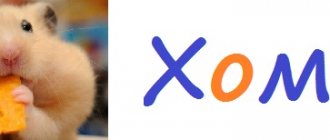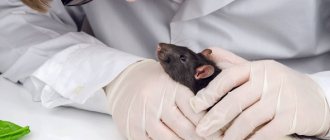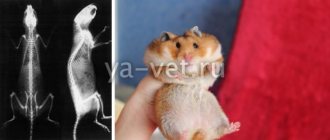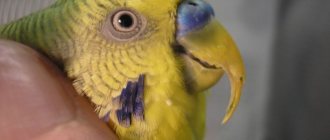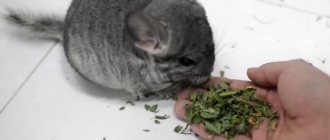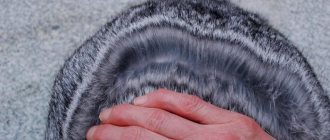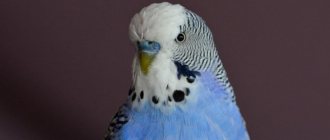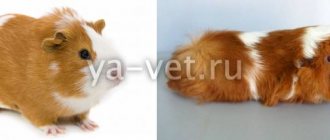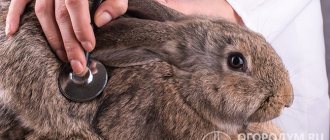Signs of ill health
You can suspect the presence of the disease based on the following signs:
- Change of behavior. The chinchilla becomes lethargic.
- Loss of appetite.
- Nasal or conjunctival discharge.
- Diarrhea.
- Dermatitis.
- Hair loss.
- Change in tooth color.
- Unpleasant odor from the mouth.
- Pathologies of the genital area.
Having noticed such symptoms, the owner is obliged to find out whether the conditions of detention, as well as the pet’s nutrition, comply with the recommended standards, and correct the detected deficiencies. The biology of a rodent is not comparable to that of a human, so trying to treat a chinchilla disease can do more harm than doing nothing.
It's sad to be sick
How to understand that a chinchilla is sick
To understand that a chinchilla is sick, just take a closer look at your pet’s behavior. Healthy chinchillas have constant habits and habits. If the pet is healthy, then it:
He has a good appetite, behaves calmly, and responds adequately to attention from people. Outwardly looks healthy - eyes are shiny and not damp; no growths or dirt on the ears and genitals; the fur is smooth, shiny and thick; nose is clean; the teeth are orange and straight. Eliminates round feces, does not lose weight (normal weight for chinchillas is 400-600 grams).
Thus, chinchilla diseases somewhat change their behavior. You can suspect something is wrong when your pet:
- Becomes lethargic, apathetic, may refuse to play and communicate, sleeps a lot.
- Refuses to eat and drink and may dig into food for a long time.
- Looks unhealthy - eyes are watery, wet and swollen; nasal discharge appears; corns and ulcers appear on the body, hair falls out and becomes greasy, etc.
- Sneezes, coughs, wheezes, constantly with his mouth open.
- He defecates with diarrhea and there is red discharge in his urine.
- He is rapidly losing weight.
- Possesses impaired coordination, convulsions and various seizures occur.
When such external symptoms appear, you should immediately contact a specialist to find out the causes.
This is important, because some chinchilla diseases can be transmitted to humans, and the cure will be a problem that will require time, effort and money to resolve. Among the diseases dangerous to humans are microsporia (chinchilla lichen), tuberculosis, rabies and others.
They are dangerous for your pet, possibly fatal.
Heatstroke
Chinchillas lived in the wild in the highlands of South America. They are susceptible to drafts, but most of all to overheating. A temperature of 25 °C is critical for them. This should be taken into account by chinchilla farmers and animal lovers. The main symptoms of overheating are the following:
- Copious salivation.
- Diarrhea.
- Rolling to one side.
- Cramps.
Hyperthermia disrupts the functioning of chinchilla kidneys and myocardium. Without taking action, this condition ends in death. What should an owner do if a chinchilla gets sick before the veterinarian arrives? Transfer the animal to a dark, cool room and cover it with a cloth moistened with cool water. If the attack occurs on the street or in transport, the cage with the rodent must be moved to the shade: the chinchilla does not tolerate direct sunlight.
The sounds they make
When communicating with children, a chinchilla may make a sound similar to whining. She may also whine when she is bored or when someone of the opposite sex is nearby. When a pet whines, but does it less often and sharply, it means that he is looking for something or asking, for example, to open the cage, give him food, or if the cub is lost.
If a chinchilla is interested in something, it will squeak easily and quickly. She makes this sound especially often when she runs around the apartment and new premises, since there is a lot of interesting things around. When a male shows interest in a female, he begins to grunt frequently, thereby indicating this
He also begins to beat his tail, trying to attract attention. In response, the female may react aggressively, she will begin to quack loudly and sharply, and if the male does not stop pestering her, she may even bite him
At this moment it is better to monitor their behavior.
Respiratory diseases
Chinchillas may develop a runny nose or bronchopneumonia. The animals lack not only sweat glands, but also sebaceous glands. Therefore, chinchilla diseases occur under the influence of a draft, wetness; the animals catch cold easily, and their treatment begins with eliminating the cause.
Rhinitis
In chinchillas kept in an apartment, inflammation of the nasal passages is a consequence of drafts; those living in sheds can get sick due to hypothermia or sudden temperature changes. An allergic reaction to dust, including from excessively crushed feed, cannot be ruled out. The following symptoms occur:
- The nasal mucosa becomes inflamed.
- Breathing is difficult.
- The animal is depressed, rubbing its nose with its paws. He's shaking.
- Runny nose with copious nasal excreta.
- Tearing
- Hyperthermia >38 °C.
If production livestock gets sick, the sick are removed and the rest are treated. Sanitation of the premises with Chloride turpentine in the presence of animals is in demand. Treatment of chinchillas is carried out in courses lasting 5 days. After 2–3 days, the sanitation is repeated. If the need arises, the number of courses is increased to 8. If timely treatment is not carried out, the disease will spread to the underlying sections, bronchopneumonia will form and the animal will die. For preventive purposes, rodents are treated weekly.
At home, antiseptic solutions are dripped into the nose. Penicillin, tetracycline, and sulfonamides are effective. The course of treatment is not <5 days. In severe cases, intramuscular injections must be made.
Bronchopneumonia
If the animal develops wheezing, coughing, matted fur, or the temperature rises to 41°C, this indicates the occurrence of bronchopneumonia, so it is necessary to call a veterinarian who has experience working with ornamental rodents.
Otitis
Occurs in individuals with weakened immune systems or when exposed to drafts or changes in external temperatures. Characterized by rubbing the ears against the cage, scratching them. Pus may leak from the external passage and an unpleasant odor may be felt.
Exudate must be removed using an antiseptic lotion. Do not use warming compresses that create conditions for the proliferation of microflora.
Venipuncture
In chinchillas, the lateral saphenous veins of the thoracic and pelvic limbs are recommended for venipuncture. An ear vein is recommended to take a small amount of blood. You can also take blood after trimming the claw, since chinchillas have vestigial claws and there will be no traumatic pain or severe bleeding. Table 3 shows the hematological and biochemical indicators of normal chinchillas.
| Table 3. Hematological and biochemical parameters of chinchilla serum normal | |
| Hematocrit (%) | 27-54 |
| Red blood cells (106/ml) | 5,6-8,4 |
| Hemoglobin (g%) | 11,8-14,6 |
| Leukocytes (103/ml) Neutrophils (%) Lymphocytes (%) Monocytes (%) Eosinophils (%) Basophils (%) | 5,4-15,6 39-54 45-60 0-5 0-5 0-1 |
| Alanine aminotransferase (IU/l) | 10-35 |
| Alkaline phosphatase (IU/l) | 6-72 |
| Aspartate aminotransferase (IU/l) | 96 |
| Total bilirubin (mg/dl) | 0,6-1,28 |
| Calcium (mg/dp) | 5,6-12,1 |
| Chloride (mEq/L) | 108-129 |
| Cholesterol (mg/dl) | 50-302 |
| Creatinine(mg/dl) | 0,4-1,3 |
| Glucose (mg/dl) | 109-193 |
| Phosphorus (mg/dl) | 4-8 |
| Potassium (mEq/L) | 3,3-5,7 |
| Total protein (g/dl) Albumin (g/dl) Globulin (g/dl) | 3,8-5,6 2,3-4,1 0,9-2,2 |
| Sodium (mEq/L) | 142-166 |
| Urea nitrogen (mg/dp) | 17-45 |
| Taken from Carpenter JW, MashimaTU, RupiperDJ: Exotic Animal Formulary. Manhattan, KS: Greystone Publications, 1996. |
Eye diseases
Eye diseases in chinchillas can manifest themselves as an independent pathology and as a symptom of another illness, mainly respiratory. Additional symptoms besides lacrimation are:
- Cough.
- Nasal discharge.
- Depressed state.
- Labored breathing.
Tearing is detected by wet streaks on the rodent's cheeks. It is necessary to carefully consider the identified symptoms, take measures against the development of rhinitis and call a veterinarian. The most common eye diseases in chinchillas are:
- Conjunctivitis.
- Keratitis.
- Cataract.
Conjunctivitis
Inflammation of the conjunctiva in chinchillas can be primary or secondary. The former is caused by injury or irritation from solid or gaseous substances entering the eye. Secondary conjunctivitis occurs as symptoms of another disease.
Animals receive injuries as a result of fights or damage received during transplantation. It is significant that with conjunctivitis of infectious etiology, both eyes are affected, and with injuries, most often one. Getting dust or food particles into your eyes irritates them and causes watery eyes. If the cage is not cleaned, corrosive gases are released from the decomposing feces, which “cut” the eyes. Smoking in a room with a chinchilla can cause lacrimation in the sensitive animal.
Conjunctivitis is treated with eye drops. How to treat it at home").
Conjunctivitis
Keratitis
Develops from conjunctivitis. If not properly treated, serous discharges transform into mucous discharges, then purulent ones. The cornea is involved in the phlogistic process and keratitis develops. The animal is at risk of losing its sight.
Ulcers form. Treatment can stop the inflammatory process, but the defects become scarred and visual acuity decreases.
Cataract
The disease is characterized by loss of transparency of the lens. The ability to transmit light, and therefore to see, is lost. The cause of the pathology is unknown. There may be an innate predisposition to developing the disease. A cloudy lens in a pet is hard to miss. Highly qualified veterinary specialists have learned to perform lens replacement operations. There is a chance of restoring your pet's vision.
Cataract
Poisoning
Poisoning is a dangerous and serious disease. There are many reasons for poisoning, most often from bacteria or poor quality food. Check your chinchilla's throat first because the symptoms may be similar when a foreign object is lodged in the chinchilla's airway.
Symptoms of food poisoning in chinchillas:
- Vomiting or urge to vomit
- Mucus or foam around the mouth or nose
- Weakness and reluctance to move
- There may be bloating in the stomach
- Sometimes accompanied by diarrhea
Poisoning can cause new diseases and often lead to death if treatment is not started in time. If you see that the animal’s condition is worsening every hour or two, it is better to contact a veterinarian before irreversible consequences occur.
If your pet is feeling normal and stable, you can treat it yourself.
Treating the infection is quite difficult and it is best to contact a veterinarian. Unfortunately, there is very little information on treatment on the Internet; in this article we have collected all the instructions on how to independently help a chinchilla with food poisoning.
Foreign body stuck in throat
Sometimes chinchillas get stuck with foreign objects, most often pieces of food.
Symptoms of getting stuck:
- Saliva flows profusely
- Vomiting or just urge
- Mucus around the mouth or nose, less often foam
- Sneezing
- Abnormal breathing, often heavy
Removing a foreign body yourself is quite difficult and dangerous; it is best to entrust this task to a veterinarian. If the item is large, then there is a risk of losing your pet in just a couple of hours.
The symptoms are very similar to poisoning, so a visit to the veterinarian will be doubly helpful. The doctor will make an accurate diagnosis, remove the foreign body if there is one, and if it is poisoning, he will give the necessary medications.
If you decide to remove a foreign body yourself, then first read the article on how to do this and step-by-step instructions.
Anomalies of teeth
Healthy chinchillas, like nutrias, have bright orange-colored teeth. Dents subject to decalcification become pale yellow. The main reason is an imbalance in the diet in terms of minerals and vitamins or selective eating of certain ingredients by the chinchilla. The most reliable way to get rid of the disease is to use complete granulated feed. The animal is deprived of the opportunity to choose and consumes all the necessary substances.
Healthy teeth
An imbalance of nutrients provokes the development of a difficult-to-treat dental disease - drooling. It lies in the unevenness of dental growth. The animal has increased salivation, it scatters food and selects softer particles. Gradually, the nose and eyes become inflamed, and discharge forms from them.
Another pathology that causes significant concern to the chinchilla is hooks on the dents. This is a congenital disease characterized by the formation of malocclusion. Treatment boils down to grinding down the teeth with a drill using general anesthesia. You need to understand that sawed incisors grow back. After 6 months the operation must be repeated.
Sick teeth
Avitaminosis
Poor quality food can cause a lack of vitamins and minerals in the chinchilla’s body. With a lack of vitamin A in the body, the animal experiences inflammation of the mucous membrane of the eyes. To solve the problem, it is necessary to increase the amount of this vitamin in the diet. With a deficiency of vitamin B1, more serious symptoms may appear: the animal begins to drag its hind legs, loss of coordination occurs, and it is difficult for it to stand on its paws. In the worst case scenario, an intramuscular injection of the vitamin may be needed. To prevent vitamin deficiency, you should take care of a balanced and complete diet for your chinchilla.
Nutritional diseases
Diseases of chinchillas, characterized by an upset stomach, occur when feeding low-quality or improperly prepared food. Digestive disorders are caused by dusty or moldy hay or a sudden change in diet. Before giving the animal treats, you need to study the available literature, finding out what is possible, in what quantity, and what should be discarded. The best option is to feed industrially prepared granular feed. Farmers raising chinchillas, in order to reduce the cost of feed, can prepare it themselves by copying the recipe.
Healthy food for chinchillas
Most often, chinchillas experience the following diseases of the alimentary tract:
- Gastroenteritis.
- Flatulence.
- Constipation.
- Diarrhea.
Gastroenteritis
The disease is characterized by diarrhea that occurs as a result of feeding errors or as a symptom of another illness. Dysbacteriosis may develop as a result of uncontrolled use of antimicrobial agents. It is necessary to monitor the water; pathogenic microflora develops in it if it is rarely changed. The animal is advised to fast for one and a half days, boiled water, followed by feeding with pellets. As antidiarrheal agents, you can use astringents at home - oak bark, etc., or natural sorbents, for example, Smecta. The use of antimicrobial medications is carried out under the supervision of a veterinarian.
This food can harm your chinchilla
Constipation
The cause of the disease may be adynamia or overfeeding the animal with some kind of delicacy. In this case, fasting, the use of an enema or laxatives are indicated.
Flatulence
This disease occurs due to the fault of the rodent owner who fed him fresh or stale greens. The animals are depressed, lie motionless, the abdomen is swollen, and significant hypothermia is observed. The chinchilla is given sorbents and the stomach is massaged. It is better not to use antimicrobial agents without consulting a veterinarian.
Digestive system disorder
Chinchillas can have both diarrhea and constipation. Both of these diseases are quite dangerous for animals.
If an animal has diarrhea, it is quite easy to see.
Loose stools can be caused by food that is of low quality or has expired.
It happens that diarrhea occurs due to the fact that the animal drinks dirty or spoiled water.
Also, the cause of intestinal upset can be the fact that the animal overeats food rich in vitamins and useful elements.
If you feed your chinchilla plant food, each product will have its own effect:
- branches of linden, apple, and currant can contribute to loose stools;
- oak, pomegranate peels, chamomile help normalize stool.
- If your pet does develop slight diarrhea, there is no need to rush and give him smecta or bifidumbacterin.
- You must first replace the litter in the tray, change the water to fresh water, and remove the bowl of food.
- You need to give the animal hay with stool-fixing properties or activated carbon.
Constipation is rare in chinchillas.
In this case, the animal’s feces become very small.
- You can help your pet by feeding him fresh grass.
- If constipation continues for several days and the animal does not improve, treatment should be started.
The best medicine would be Regulax. The drug is added to the water that the animal drinks: approximately 3 drops per half liter of water.
Skin pathologies
The following types of skin diseases are distinguished in chinchillas:
- Lichen.
- Ectoparasites.
- Gnawing of fur.
Lichen
The biggest concern for the chinchilla and its owner is lichen. Humans are also susceptible to this fungal disease. Pathological fungi are ubiquitous, and under optimal housing and feeding conditions they do not cause disease. Warmth and dampness are required for their development. When kept in groups, the fungus, passing through many organisms, significantly increases its virulence, causing mass diseases. With lichen, itching, peeling of the skin, and the appearance of areas of baldness are observed. External antimycotics used in veterinary practice for treating small domestic animals are effective in treatment.
Ringworm on the ear
Along the way, they find out whether the animals are properly kept and fed. The shortcomings are eliminated. Perhaps the cause of dermatitis is not a fungus, but hypovitaminosis. Chinchilla breeders report that immunization with an anti-lichen vaccine helps with lichen. This fact has not received official confirmation, therefore, before conducting such experiments, you should consult a veterinarian.
Ectoparasites
The disease is characterized by itching, hair loss, and restlessness of the animal. Fleas come from other pets. Many insecticides that are harmless to other pets are toxic to rodents, so chinchilla breeders recommend bathing them in Bromocyclen solution and using flea collars for kittens and puppies. At the same time, owners need to take care of eliminating fleas in the apartment.
Gnawing fur
Chinchillas begin to chew out hairs due to an unbalanced diet, poor living conditions, or as a result of disruption of the functioning of the endocrine glands. Alopecia occurs throughout the body, damaging the skin. The situation can be corrected by switching chinchillas to professional balanced food. If isolated cases are identified, the sick ones are removed so that other animals do not follow their example.
Gnawed out her own fur
Chinchilla has worms and hair is coming out
Chinchilla has worms and hair is coming out
Message number: #1 Alexey » Mon Jan 05, 2009 01:28
If you do not want to see this block, register or log in under your name.
Message number: #2 Anika » Mon Jan 05, 2009 10:26
In order
1. We had the same thing, we took tests and said that it was not lichen, we didn’t treat it with anything, and after some time new lesions appeared. They began to treat with Exoderil (an antifungal agent (solution) sold in human pharmacies). In principle, chinchillas do not have many skin diseases accompanied by hair loss. This could be alopecia (hair loss), they don’t really know what causes it, but they assume that due to poor nutrition, lack of vitamins, the fur will grow back after some time with proper care. Eating their own fur is caused by changes in the adrenal glands and pituitary gland (it is quite rare and looks terrible, in chinchillas something appears in the form of a lion's mane). So this is definitely not your case. Well, Dermatotoxicosis (fungal diseases), but this disease manifests itself by the appearance of a crust on the skin or peeling. Well, if we take into account all of the above, then there are 2 options: either hair loss, or lichen, or simply pulled out or thrown off as a result of stress (but the clump is quite large. In general, I doubt it). So you need to give vitamins. for example, biovital gel (squeeze a “bead” onto your finger and let it be licked off) or immunoboosting drugs (imunofan or gamavit), and for preventive purposes, anoint with exoderil.
2. Give calcium gluconate half a tablet once a day, most often the chinchilla itself knows how much it needs to eat, chews as much as it needs and throws the tablet. Watch the color of your teeth. Teeth are an indicator of calcium in the body. Should be dark yellow or orange. If your teeth are light, it means there is not enough calcium.
4. It’s damp on the balcony now, so it’s better to store hay and sand in a dry, dark place in the apartment. The best food for chinchillas is Vitacraft Regular, Vitacraft Pellets, Prestige Duo and Prestige Complete. I would exclude Grand Premium from my diet. Prestige nature or xtra-vital can be given as complementary food. I can’t say anything about hay, we haven’t tried it, but what good hay looks like is written in the article with the quote “Hay is an essential part of a chinchilla’s diet. It is better to use meadow hay, with dandelions, clover, alfalfa, and not swamp hay. Swamp hay contains much less useful nutrients than meadow hay. The mowed grass should be young, not yet having time to spike. A point to pay attention to is drying the hay. You need to dry the hay in a dark, well-ventilated place so that it dries thoroughly, does not rot, rot, or lose its beneficial properties. If it is not possible to make hay yourself, then you should be very careful when choosing hay when buying it in a store. The color of good hay is dark green, the yellow blades of grass (straw) in it are no more than 15 percent. The hay should not smell like mold or rot. The hay must be clean, without tree branches or other debris.” Sand. We haven’t tried it either, but you can diagnose it yourself. Peanuts should not be given to chinchillas at all; it is too heavy and fatty food for the chinchilla’s liver. They usually give a quarter of a walnut to pregnant females. It is better to treat the chinchilla with rose hips or give a little dried apple.
5. Chinchillas rarely have worms and worm prevention is usually not done. If you are sure that there are worms, then you can poison them with albendazole or alben s (in fact, this is the same
) the dosage in accordance with the instructions is calculated depending on the weight of the animal.
The fur must run!
My chinchillas: https://chinchillas.by/
. It depends only on the choice of the breeder whether your animal will grow up to be “That’s something!” or “Oh, what is this?!”
Message number: #3 KulMaks » Mon Jan 05, 2009 11:50
I think things could be much simpler. If you bought a chinchilla a month ago, and noticed a lack of fur two weeks ago, then most likely the reason is the move. I doubt it's lichen or other fungal diseases. Most likely a sharp transition to new food, new impressions of moving, new smells, etc. As a result, a malfunction in the body and hair loss. I would recommend monitoring the coat for a week (regularly checking the entire coat for new bald spots by blowing it out). In a week or a week and a half, hair will begin to grow back at the site of the bald spot. If no new outbreaks appear, we can assume that everything is fine
PS It’s right that you didn’t wet the chinchilla
Message number: #4 Lili » Mon Jan 05, 2009 21:34
Message number: #5 Dashka » Mon Jan 05, 2009 21:42
Message number: #6 Anika » Mon Jan 05, 2009 23:01
Urogenital diseases
The following pathologies are distinguished:
- Urolithiasis disease.
- Diseases of males.
- Pathologies of females.
Urolithiasis disease
The cause of the pathology is a cold, an unbalanced diet or the use of spoiled feed. Initially, cystitis develops, characterized by oliguria, the appearance of blood in the urine. If the inflammatory process has led to the formation of stones, urination is painful for the chinchilla. The animal staggers, it spins, whines, arches its back. Sulfonamides are used to suppress microflora that cause inflammation. If treatment does not help, fluoroscopy is performed and the stones are surgically removed or the chinchilla is culled.
Diseases of males
Males suffer from a lack of libido. Pathology occurs with poor feeding or excessive sexual activity. A ring of hair may form around the penis, preventing it from coming out completely. The fur formation is carefully removed. Sometimes the penis falls out of the preputial sheath. He's being adjusted. In both cases, males are prescribed increased feeding and two weeks of abstinence.
Ready to breed
Pathologies of females
The following pathologies may occur in chinchillas:
- Endometritis. Characterized by purulent dark-colored discharge. The female and male are separated and treated with antibiotics to prevent another chinchilla from becoming infected.
- Pyometra. A pet's uterus is removed.
- Urethral prolapse. Occurs during coitus. The operation is indicated.
- Difficult birth. The pet owner must understand that if the chinchilla is unable to whelp, a caesarean section will be required.
- Toxicosis of pregnancy. Appears when there are nutritional disorders, for example, overfeeding with treats. The prognosis is unfavorable.
- Abortion. They occur due to feeding disturbances, as well as rough handling by the chinchilla breeder.
Overheating (hyperthermia)
A very dangerous and life-threatening condition. Chinchillas feel comfortable at temperatures up to +18°C. The maximum permissible temperature is +25°C; higher temperatures are hazardous to health. They do not have sweat glands, so they cannot cope with excessively high temperatures.
When the temperature rises above +25°C, the chinchilla begins to feel worse and may get overheated, and at a temperature of +30°C, overheating can occur instantly and within a few hours the chinchilla will die
It is important to identify overheating in time and begin its treatment.
Symptoms that indicate overheating:
- Lethargic state, practically motionless
- Seizures
- Convulsions
- Lying on side or stretched out
- Saliva is thick
- Tongue bright red
First of all, you need to help the chinchilla with improvised means to alleviate its condition. Wet the paw pads and outside of the ears with cool water. Move the chinchilla to a cool, ventilated room without drafts. Or you can put it in a metal bathtub or on a cold tile floor. Try giving your chinchilla water.
It is very important that you do not cool it suddenly and do not put it in the refrigerator under any circumstances. Sudden cooling will lead to new diseases or death of the animal
Why is it important to take your chinchilla to the vet?
The veterinarian has invaluable experience that will help relieve the temperature faster and bring the pet back to normal. In addition, the doctor will be able to assess the condition and determine whether other organs are damaged, and then prescribe the necessary treatment.
!!!If the necessary measures are not taken in time, there will be irreversible changes.
If the overheating was severe, then you will have to leave the animal for several days in the vet. clinic until complete recovery. This pleasure is not cheap, but here it is up to you to decide whether to spend money on treatment or leave the chinchilla to chance.
How to cure overheating yourself.
ATTENTION! This information is provided by the chinchilla owner and taken from the forum. We do not guarantee a 100% cure for your chinchilla, so we recommend contacting your veterinarian.
We left this method of treatment in case the owner does not have a single veterinarian nearby.
STORY FROM THE OWNER ON TREATING OVERHEATING
It happened late at night, the chinchilla showed all the symptoms of overheating. Calls to veterinarians known to me. the clinics were unsuccessful. First of all, the chinchilla was moved to a cool room and ice was applied to the head through a towel. As a result, I managed to get through to one of the clinics, where they could only help me with a prescription. In addition, they said that it was unlikely that they could help such a fragile creature, but I decided to try.
Here's what they advised us and in the end it saved the chinchilla:
Prednisolone - 0.1 IM
Eufillin (2.4%) - 0.1 s.c.
Furosemide (Lasix) - 0.2 s.c.
Additionally, a little more Furosemide (Lasix), because the chinchilla did not pee after the first dose of medicine.
The chinchilla was still kept cool by applying cold to the head and ears. Now all that was left was to wait for everything to take effect.
Closer to 4 am, the first signs appeared that the medications were helping. My head stopped twitching nervously, I peed a couple of times and at least some movement began. An hour after the improvements, they stopped applying cold and put him in a cage separate from the other animals. Having been placed in a cage, they immediately poured water with glucose, which she happily drank. A few minutes later she went to bed.
After sleeping a little, of course, we too, injected another 0.3 Sulfocamphocaine IM. After a couple of hours, she already started eating hay. That same evening, the animal became very active and showed no signs of ill health. Just in case, we transplanted her into a common cage only every other day, constantly watching and feeding her plenty of water.
The chinchilla survived because help was immediate. We didn’t bring her to the point where they were already starting to fall, but decided to start treatment right away.
Now it’s worth telling why this happened. It was hot summer weather, and naturally they sat in a cage during the day. And in the evening, when it became quite cool, according to my feelings, the chinchillas begged for a walk with their gaze. The coolness turned out to be deceptive; the chinchillas frolicked for a long time and ran around a lot. Of the 2 chinchillas, only the girl was injured, for what reason I don’t know, maybe she is weaker, but most likely it is due to the excess weight that she suffers from.
I strongly recommend that you do not walk with chinchillas in hot summer weather. Even at +22-25 degrees with intense physical activity they can get severely overheated.
Constipation
This disease is typical for young individuals, males or pregnant females. In many cases, it ends in death or rupture of the intestinal walls. The development of constipation in a chinchilla can be provoked by infection, the presence of a large amount of concentrated food in the diet, lack of drinking water, stress, and lack of space for movement.
Signs: if a rodent has not had a bowel movement for several days, constantly sits in a corner, is hunched over, or climbs on the walls, this means that it is constipated, and in most cases in the cecum. If you lightly palpate the abdomen, you can feel the place where feces have accumulated.
Treatment: with timely diagnosis, constipation can be cured by introducing succulent green foods, juices and fruits that contain a lot of fluid into the diet. If constipation is more severe, you can try injecting paraffin oil into the rectum and mouth. This oil will help improve the passage of stool through the intestines.
Injuries
Every chinchilla is at risk of injury. This happens both during a fight with a relative and in ordinary everyday life. Wounds and abrasions appear throughout the animal’s body
It is important to immediately treat them with Levomekol ointment or simple hydrogen peroxide. Sometimes fractures happen
In this case, a trip to the veterinarian cannot be avoided, because only a specialist can accurately determine the location of the damage and its severity.
Closed fracture
With such an injury, it is worth applying a splint. It is not difficult to build it yourself. You will need a piece of rubber hose, which is cut in two lengthwise and secured to the broken limb with threads. In one and a half to two weeks the hand will grow together
It is important to know that the animal will try to chew off the damaged paw. It is worth not forgetting about this feature of the rodent when treating
Open fracture
This injury leads to amputation of the limb. This procedure can only be performed by a veterinarian. After surgery, the wound is treated with hydrogen peroxide and anesthetized using Lidocaine. You will also have to use antibiotics to help prevent infection.
Digestive system disorder
Chinchillas can have both diarrhea and constipation. Both of these diseases are quite dangerous for animals.
Diarrhea
If an animal has diarrhea, it is quite easy to see.
Loose stools can be caused by food that is of low quality or has expired.
It happens that diarrhea occurs due to the fact that the animal drinks dirty or spoiled water.
Also, the cause of intestinal upset can be the fact that the animal overeats food rich in vitamins and useful elements.
If you feed your chinchilla plant food, each product will have its own effect:
- branches of linden, apple, and currant can contribute to loose stools;
- oak, pomegranate peels, chamomile help normalize stool.
Fresh green grass can also loosen stools. In general, fresh foods should be limited in a chinchilla’s diet. It is advisable to give everything in dried or dry form.
- If your pet does develop slight diarrhea, there is no need to rush and give him smecta or bifidumbacterin.
- You must first replace the litter in the tray, change the water to fresh water, and remove the bowl of food.
- You need to give the animal hay with stool-fixing properties or activated carbon.
Constipation
Constipation is rare in chinchillas.
In this case, the animal’s feces become very small.
- You can help your pet by feeding him fresh grass.
- If constipation continues for several days and the animal does not improve, treatment should be started.
The best medicine would be Regulax. The drug is added to the water that the animal drinks: approximately 3 drops per half liter of water.
